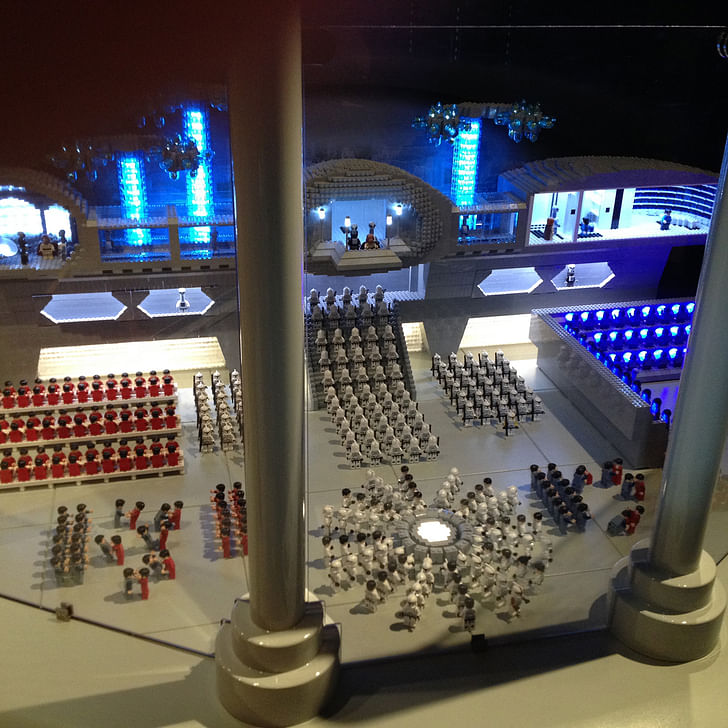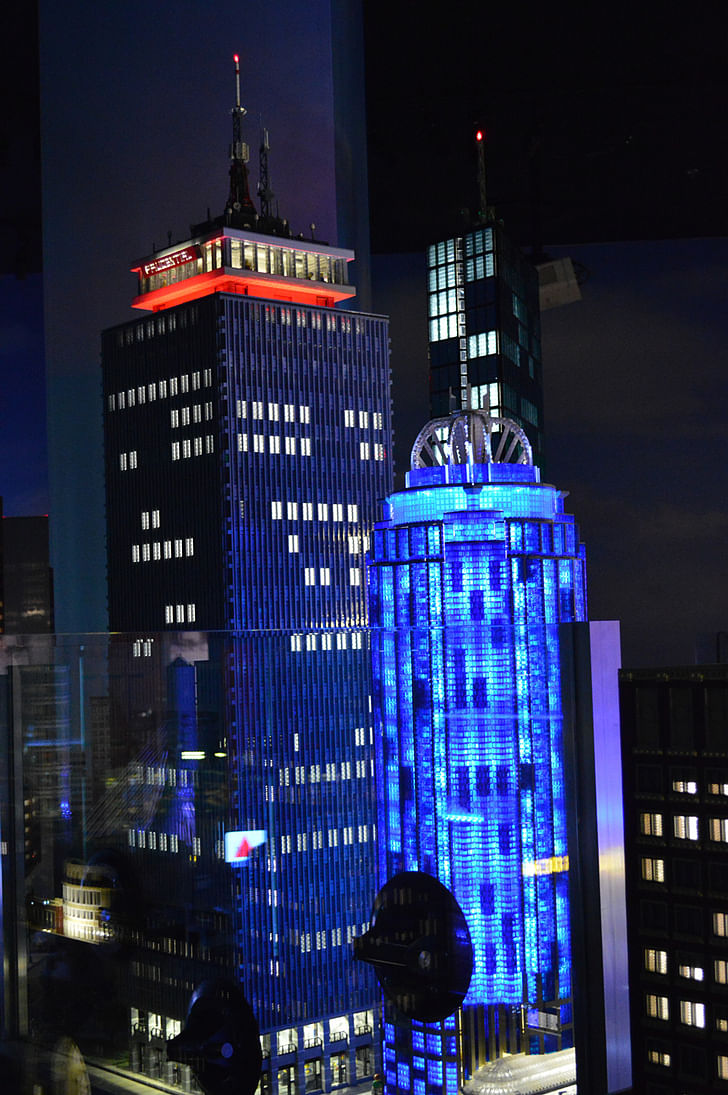

Working out of the Box is a series of features presenting architects who have applied their architecture backgrounds to alternative career paths.
In this installment, we're talking with Adora Lo, LEGO model designer.
Are you an architect working out of the box? Do you know of someone that has changed careers and has an interesting story to share? If you would like to suggest an (ex-)architect, please send us a message.
It's a common architect's folktale: reflecting on how they first became interested in the profession, the architect lovingly recalls a childhood spent building with LEGOs. But in fact, their present reality is rarely imbued with the playful, imaginative hues of that memory. Unless of course, you’re a professional LEGO model designer like Adora Lo.
A classic case among graduates at the peak of the financial crisis, Lo’s academic pedigree in architecture wasn’t getting her work where she wanted it. She took a job with Merlin Entertainments and was pleasantly surprised to find the little plastic bricks still managed to bring joy — both to her, and the millions of LEGOLAND visitors all over the world, experiencing her creations.

Where did you study architecture?
University of California, Berkeley, B.A. in Architecture, December 2005. University of California, Los Angeles, Masters of Architecture, 2009.
At what point in your life did you decide to pursue architecture?
As a kid, I really enjoyed LEGO and using it to create buildings, never sculptures. During my last year of high school, I took a vocational test for fun, and it indicated architecture as a good fit for me. I remembered what I built as a kid, and with no clue what to pursue at the time, I decided to go for it, figuring that I could change majors after the first class. After my first semester, I enjoyed it so much that I stayed all the way through.

When did you decide to stop pursuing architecture? Why?
During the last year of my Masters program, I was feeling burned out, but I still loved making models. My graduation coincided with a pretty harsh job market in 2009, so I worked parttime jobs until I found a job listing for a LEGO model builder. Meanwhile, I continued to send my portfolio out to firms, who kept telling me they were looking for more experienced interns.
While my old college friends complained about doing bathroom details all week, I talked about soldering lights for a 9 meter high LEGO model of the Petronas TowersI stopped pursuing architecture after a year as a model builder, because I really enjoyed what I was doing, and being out of the profession for a full two years at that point, I felt that returning to architecture would be improbable, especially in San Diego county. I was actually putting my knowledge to use, just in a different medium. While my old college friends complained about doing bathroom details all week, I talked about soldering lights for a 9 meter high LEGO model of the Petronas Towers for LEGOLAND Malaysia.
I joke to my friends that I have the best job in the world because everyone tells me so, but there’s some truth to it. Often when I meet new people who ask me what my job is, I tell them, “I design and build LEGO models for LEGOLAND California Resort and LEGOLAND Parks around the world,” and I see their faces light up. It’s a dream job for every kid and probably some adults as well.


Describe your current profession.
My official title is Model Designer, based out of LEGOLAND California Resort, and I design new architectural and sculptural models for LEGOLAND resorts worldwide. There are five model shops on three continents dedicated to creating new models for LEGOLAND resorts, My knowledge of Rhino 3D definitely helped, along with all the practice of drawing plans and sections, since I’m one of the few people in our model shop who can quickly create steel fabrication drawings accurately and neatly.and I am one of nine designers in California, which is one of the larger shops.
I use LEGO’s proprietary software and Rhino3D to create either scaled down versions of architectural landmarks or fun sculptural models. I also build prototypes to figure out how a model will come together, since there are construction techniques that are easier to visualize and test by physically building a model.
I’m also a Team Lead, managing a group of seven builders. I hand out projects, quality check their work, and facilitate other administrative needs. I never expected to go into any kind of management position, nor did I want to in the beginning, but after almost a year of being in this role, I’m enjoying it more than I thought I would.
What skills did you gain from architecture school, or working in the architecture industry, that have contributed to your success in your current career?
My knowledge of Rhino 3D definitely helped, along with all the practice of drawing plans and sections, since I’m one of the few people in our model shop who can quickly create steel fabrication drawings accurately and neatly. Also, all that time in school developing an eye for design and abstraction helps me now in boiling down what details I need to recreate a building in LEGO and still have that building be recognizable to the public in an instant.
One of the rules we have is that whatever we build, it has to be doable by anyone if they have the money and time. We can’t cheat, we can’t just glue things together and call it a day. The restrictions of the LEGO system are something that we have to work with, and being able to put together an elaborate design and still have it be “LEGO legal” is a fun challenge. I’m always using my architectural knowledge to figure out how far I can cantilever something before it needs support, and how many beams and columns I need to put into a building before it collapses in on itself.


Do you have an interest in returning to architecture?
I don’t think I’ll be designing real buildings any time soon. There are ups and downs, but at the end of the day, I’m happy being a model designer and creating models for everyone to enjoy. Usually after our team has delivered a project and the attraction has opened, we’ll see press videos of how the public reacts to our models. When I see children and parents pointing at something I’ve made and saying, “Oh, that’s SO COOL!” with giant grins on their faces, I feel really satisfied with my work. And where else can I say that I’ve designed a When I see children and parents pointing at something I’ve made and saying, “Oh, that’s SO COOL!” with giant grins on their faces, I feel really satisfied with my work.Star Wars building in LEGO?
I also enjoy the variety of projects we receive at the model shop. Sometimes we have large orders of hundreds of models to fill a new LEGOLAND park, or we have small orders of two or three sculptural characters to fill in an empty spot in an existing park. We’ve built Star Wars, Florida, Malaysia, Boston, and soon we’ll be taking on the challenge of Dubai. Also the turnaround for projects is much faster here than it is for actual buildings. It takes from a few months to sometimes only days for a single project, and I like the fast pace and the constant change.
One day I’d like to move forward in my career in a theme park creative position, designing different attractions or even whole parks, instead of just the models within. I can’t think of a degree that could possibly have prepared me more for that path than architecture.

Former Managing Editor and Podcast Co-Producer for Archinect. I write, go to the movies, walk around and listen to the radio. My interests revolve around cognitive urban theory, psycholinguistics and food.Currently freelancing. Be in touch through longhyphen@gmail.com
1 Comment
I really enjoy reading these stories- thanks. That Boston model is impressive. The Lego version of 111 Huntington is nicer than the real one!
Block this user
Are you sure you want to block this user and hide all related comments throughout the site?
Archinect
This is your first comment on Archinect. Your comment will be visible once approved.